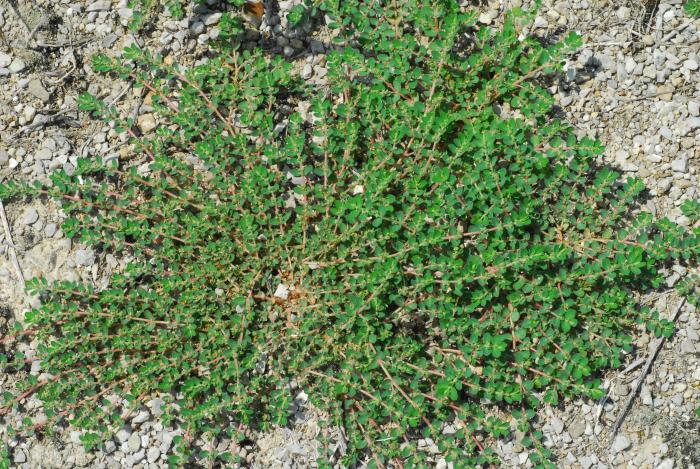Euphorbia prostrata Aiton
Groundfig Spurge

Introduced
CC = *
CW = 3
MOC = 23
© SRTurner
Euphorbia prostrata AitonGroundfig Spurge | |
 |
Introduced CC = * CW = 3 MOC = 23 |
© SRTurner |
|
Family - Euphorbiaceae Habit - Taprooted annual forb. Stem - To 40 cm, prostrate, mat-forming, sometimes with ascending tips, branched, usually reddish, densely pubescent toward tips, sometimes nearly glabrous toward base. Latex milky.
Leaves - Leaves opposite, sessile or very short-petiolate. Stipules present as small scales. Leaf blades 3-10 mm long, oblong to oblong-ovate, asymmetric at the base, broadly rounded to occasionally bluntly pointed at the tip, the margins minutely toothed and usually reddish-tinged, the upper surface glabrous or nearly so and lacking a reddish spot, the undersurface sparsely to moderately pubescent with somewhat tangled, slender hairs and usually pale or light green. Inflorescences - Axillary, of solitary cyathia or appearing as small clusters on short axillary branches. Flowers - Involucre 0.4-0.8 mm long, externally hairy, the rim shallowly 4-lobed, the marginal glands 4, 0.1-0.3 mm long and usually more or less equal in size, the body oblong to nearly circular, reddish purple to dark purple, with a relatively inconspicuous petaloid appendage 0.1-0.3 mm long, this white to strongly pinkish- or reddish-tinged. Staminate flowers 2-5 per cyathium. Ovaries hairy, the styles about 0.1 mm long, each divided nearly to the base.
Fruit - Fruits 1.0-1.5 mm long, moderately to densely pubescent toward the angles, less densely hairy to nearly glabrous between the angles. Seeds 0.8-1.2 mm long, oblong-ovate in outline, angular in cross-section, flat to slightly convex at the base, the surface with 4-7 relatively sharp, slender cross-ridges, light to dark brown.
Flowering - June - October. Habitat - Banks of rivers and sloughs, sidewalk cracks, open disturbed areas. Origin - Native to the U.S. Lookalikes - Other members of the Chamaesyce group of euphorbs, including E. maculata, E. humistrata, E. serpens, and E. stictospora. Other info. - This weedy plant occurs in scattered locations in Missouri, most commonly in counties bordering the Missouri River. Its is also found in much of the southern half of the continental U.S., most abundantly in the central portion. A clue to the identity is its flat growth habit, which is characteristic of species which were formerly classified into the genus Chamaesyce. Identification to species within this group can be difficult, and requires close attention to minute details. A key feature of this particular member of the group is the pattern of pubescence on the fruits, which are hairy on the angles but less so on the faces. The persistent styles are also very short. These characters can be variable and their determination in the field difficult. Photographs taken along the Katy Trail near Dutzow, Warren County, MO, 8-3-2012 (SRTurner). |